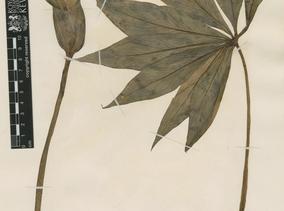Araceae
Arisaema Mart.
SUMMARY
HABIT : seasonally dormant or evergreen herbs, small to fairly large, stem usually a depressed-globose tuber producing tubercles or stolons, more rarely a branching, horizontal rhizome. LEAVES : 1-2, rarely 3, cataphylls often attractively mottled and spotted. PETIOLE : sheath usually rather long, imbricate to form a long, usually mottled pseudostem, margins either free or fused from base to apex and then with a fringed, ligulate mouth. BLADE : usually compound, trisect, radiatisect, pedatisect, very rarely simple and ovate, lobes 3-19 or sometimes more, usually lanceolate-elliptic, varying from linear to broadly ovate, elliptic or obovate, sometimes rhomboid, sessile or central leaflet often stalked, margin entire, serrate, erose or coarsely dentate; primary lateral veins of each lobe or division pinnate, forming submarginal collective vein, 1-2 conspicuous outer marginal veins also present, higher order venation reticulate. INFLORESCENCE : solitary, usually appearing with the leaves, sometimes before them, often subtended by conspicuous cataphylls, many species producing male and female inflorescences successively from the same tuber at different seasons (paradioecy). PEDUNCLE : very short to longer than petiole, rarely tuberculate in upper portion (A. scortechinii), sometimes decurved in fruit. SPATHE : marcescent, usually unconstricted, rarely slightly constricted (e.g. A. flavum), lower part erect, convolute into cylindric, often longitudinally striped tube, tube mouth often with revolute to broadly or even grotesquely auriculate margins, blade usually strongly fornicate, sometimes erect, widely expanded to galeate, apex acute to long-acuminate, sometimes drawn into very long filiform, erect or drooping thread. SPADIX : free, unisexual or monoecious, female or monoecious spadices more robust and differing from male in appendix shape and presence of sterile organs, female zone densely flowered, usually conoid, male zone usually laxly flowered and contiguous with female in monoecious inflorescences, sterile terminal appendix erect, procurved or pendent, entirely hidden within spathe to very long-exserted, usually somewhat longer than spathe tube, stipitate or not, cylindric, clavate, rounded, rugose or apically echinate or drawn out into a sometimes very long thread, rarely lacking altogether (A. exappendiculatum), often with a few subulate to filiform projections in basal part, more rarely entirely composed of long filiform projections. FLOWERS : unisexual, perigone absent. MALE FLOWER : 2-5-androus, filaments connate forming synandria, synandria ± distant from one another, sessile to long-stipitate, connective slender, usually inconspicuous, thecae shortly ovoid, dehiscing by short to long slit or pore, sometimes confluent into ± lunate or even circular compound thecae dehiscing by a single slit. POLLEN : very dry and powdery, inaperturate, spherical or subspheroidal, small (mean 22 µm., range 17-39 µm.), spinose. FEMALE FLOWER : ovary 1-locular, ovoid or oblong-ovoid, ovules 3-10, orthotropous, erect, funicle short, placenta basal, style short to attenuate, always narrower than ovary, stigma usually rather small, subhemispheric. BERRY : obovoid to obconic, rounded apically, rarely conical, usually few-seeded, bright red, rarely yellow, glossy. SEED : ovoid to globose, bearing a strophiole, testa hard, rough, light brown, embryo axile, endosperm copious.





